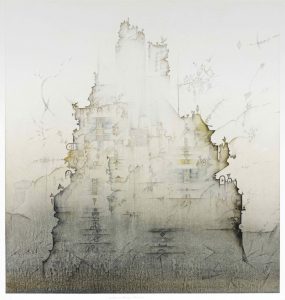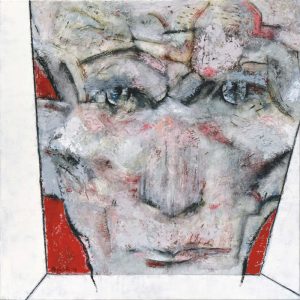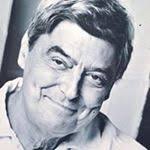In the rooms of Appartamento dei Principi in Palazzo Reale in Milan, a large monographic exhibition curated by the art critic Michele Bonuomo celebrates the work of Tullio Pericoli. It was created with the installation by Pierluigi Cerri. An extremely personal landscape interpretation. It is the territory that evaporates in a quantity of signs, dashes, sketches that mislead the discourse made up of diverging streets and streets. A world seen from the sky between shadows and shades, between contrasts of soft colors and barrel of black and signs and symbols and mathematical equations and figures. Between watercolors and ink and oil and pencil, everything falls apart, in the empty whiteness of the paper and canvas. Then it thickens, clouds, fades, and darkens. There are patches of whiteness between low clouds, you jump from place to place, between mists and forests and red lands and ridges. Intrigued and intriguing paths, fragments of distances. We are out of register, we are on a watchtower, transparencies, encroachments, combinations, confused words ….
Tullio Pericoli’s career was that of an artist with a multifaceted activity, we know his works from the pages of newspapers, from books and exhibitions, we know his portraits, published all over the world. Then he turned to the landscape “I paint landscapes – writes Tullio Pericoli – to learn their language and read their pages. A reading that always starts from geology. I also paint them to remind us that we cannot and must not get rid of memory, to follow a story that, layer by layer, unfolds for infinite times. But this is perhaps not entirely true. I don’t paint landscapes to make landscapes. I paint them mainly for the pleasure of painting, and to do one painting after another”. The exhibition hosts over 150 works that not only allow us to retrace the multifaceted production of Tullio Pericoli, but also give us the pleasure of seeing the infinite possibilities of his stroke that breaks up and reassembles the world, that mixes colors and whites and blacks, which transforms a landscape into a portrait, into a living character, a complex nature.
He accompanied, celebrated and represented the career of famous Italian writers such as Italo Calvino, Emilio Gadda and Primo Levi, and personalities from the world of cinema and the cultural scene of the twentieth century. The final section of the exhibition is dedicated to portraits of characters ranging from Franz Kafka and Friedrich Nietzsche, Eugenio Montale, Oscar Wilde, Marcel Proust and Cesare Pavese always managing to grasp their deep psychology. It is always the same sign that evaporates in landscapes and thickens into expressive lashes or wrinkles in portraits.
The beginning is fulminating with Towers and Views, works from the eighties. The Tower of Babel (1979), Watchtower (1980), Stealing from Klee, (1980), The Great Tower (1980) and the Views (1979-1980). In the mist of watercolor, these unlikely monuments impose themselves and vanish at the same time, becoming, gradually, more and more vacant. And again the works that we could call mathematics made of the same nature. Out of register, Algebra, Rain, From below, Word by Word, Filò, Crak !!!: aerial works, of infinite lightness, they make us dream of a world suspended between words and numbers, mathematical formulas and flights into nothingness.
Then all the works dedicated to landscapes between 2009 and 2020 with that touch we were talking about before, which are obviously an interior landscape as well as the Fragments (2013 – 2021), small works, 30 x 30 cm, which contain all the philosophy of the author. Sul Farsi (2018-2019) is a series in which more color appears like spots, like brush strokes. On a landscape-like basis these streaks of red, green, dark gray appear, more disturbing, more dramatic.
Info:
Tullio Pericoli. Frammenti
curated by Michele Bonuomo
13/10/2021 – 9/01/2022
Palazzo Reale
Piazza del Duomo, 12 – Milano
 Tullio Pericoli, La torre di Bruegel, 1979, acquerello e matita su carta, 71 x 103 cm
Tullio Pericoli, La torre di Bruegel, 1979, acquerello e matita su carta, 71 x 103 cm
 Tullio Pericoli, Perdita d’occhio, 2011, olio su intonaco intelato, 90 x 180 cm
Tullio Pericoli, Perdita d’occhio, 2011, olio su intonaco intelato, 90 x 180 cm
 Tullio Pericoli, Samuel Beckett, 2018, olio su tela, 55 x 55 cm
Tullio Pericoli, Samuel Beckett, 2018, olio su tela, 55 x 55 cm

Emanuele Magri teaches History of Art in Milan. Since 2007 he has been writing abroad for Juliet art Magazine. Since the 1970s he has dealt with writing and visual arts. He created taxonomically defined worlds, in which he experimented with the self-referentiality of language, such as “La Setta delle S’arte” in which ritual clothes are made starting from words with multiple meanings, the “Treaty of genetic art” in which a series of plants is obtained from grafts of human organs, eyes, hands, mouths, etc., and the project “Fandonia”, a city where everything is double and hybrid.






NO COMMENT